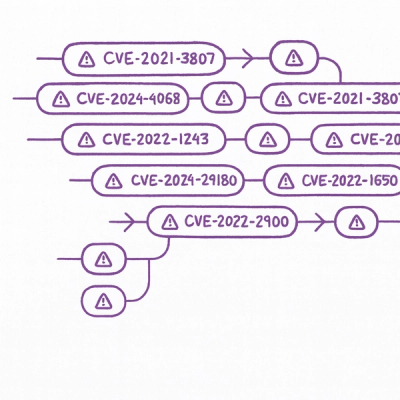
Security News
New Website “Is It Really FOSS?” Tracks Transparency in Open Source Distribution Models
A new site reviews software projects to reveal if they’re truly FOSS, making complex licensing and distribution models easy to understand.
UnHappymapper allows you to parse XML data and convert it quickly and easily into ruby data structures.
This project is a grandchild (a fork of a fork) of the great work done first by jnunemaker and then by dam5s. I found both of these projects when I started to work on a project that had a serious case of XML and required a number of bug fixes and also new features. Both of the previous maintainers are too busy or not interested in the new functionality so I have released a new gem.
###Major Differences
#to_xml support utilizing the same HappyMapper tags$ gem install unhappymapper
$ git clone https://github.com/burtlo/happymapper
$ cd happymapper
$ git checkout master
$ gem build unhappymapper.gemspec
$ gem install --local unhappymapper-X.X.X.gem
Add the unhappymapper gem to your project's Gemfile.
gem 'unhappymapper'
Run the bundler command to install the gem:
$ bundle install
Let's start with a simple example to get our feet wet. Here we have a simple example of XML that defines some address information:
<address>
<street>Milchstrasse</street>
<housenumber>23</housenumber>
<postcode>26131</postcode>
<city>Oldenburg</city>
<country code="de">Germany</country>
</address>
Happymapper will let you easily model this information as a class:
require 'happymapper'
class Address
include HappyMapper
tag 'address'
element :street, String, :tag => 'street'
element :postcode, String, :tag => 'postcode'
element :housenumber, Integer, :tag => 'housenumber'
element :city, String, :tag => 'city'
element :country, String, :tag => 'country'
end
To make a class HappyMapper compatible you simply include HappyMapper within the class definition. This takes care of all the work of defining all the speciality methods and magic you need to get running. As you can see we immediately start using these methods.
tag matches the name of the XML tag name 'address'.
element defines accessor methods for the specified symbol (e.g. :street,:housenumber) that will return the class type (e.g. String,Integer) of the XML tag specified (e.g. :tag => 'street', :tag => 'housenumber').
When you define an element with an accessor with the same name as the tag, this is the case for all the examples above, you can omit the :tag. These two element declaration are equivalent to each other:
element :street, String, :tag => 'street'
element :street, String
Including the additional tag element is not going to hurt anything and in some cases will make it absolutely clear how these elements map to the XML. However, once you know this rule, it is hard not to want to save yourself the keystrokes.
Instead of element you may also use has_one:
element :street, String, :tag => 'street'
element :street, String
has_one :street, String
These three statements are equivalent to each other.
With the mapping of the address XML articulated in our Address class it is time to parse the data:
address = Address.parse(ADDRESS_XML_DATA, :single => true)
puts address.street
Assuming that the constant ADDRESS_XML_DATA contains a string representation of the address XML data this is fairly straight-forward save for the parse method.
The parse method, like tag and element are all added when you included HappyMapper in the class. Parse is a wonderful, magical place that converts all these declarations that you have made into the data structure you are about to know and love.
But what about the :single => true? Right, that is because by default when your object is all done parsing it will be an array. In this case an array with one element, but an array none the less. So the following are equivalent to each other:
address = Address.parse(ADDRESS_XML_DATA).first
address = Address.parse(ADDRESS_XML_DATA, :single => true)
The first one returns an array and we return the first instance, the second will do that work for us inside of parse.
What if our address XML was a little different, perhaps we allowed multiple streets:
<address>
<street>Milchstrasse</street>
<street>Another Street</street>
<housenumber>23</housenumber>
<postcode>26131</postcode>
<city>Oldenburg</city>
<country code="de">Germany</country>
</address>
Similar to element or has_one, the declaration for when you have multiple elements you simply use:
has_many :streets, String, :tag => 'street'
Your resulting streets method will now return an array.
address = Address.parse(ADDRESS_XML_DATA, :single => true)
puts address.streets.join('\n')
Imagine that you have to write streets.join('\n') for the rest of eternity throughout your code. It would be a nightmare and one that you could avoid by creating your own convenience method.
require 'happymapper'
class Address
include HappyMapper
tag 'address'
has_many :streets, String
def streets
@streets.join('\n')
end
element :postcode, String, :tag => 'postcode'
element :housenumber, String, :tag => 'housenumber'
element :city, String, :tag => 'city'
element :country, String, :tag => 'country'
end
Now when we call the method streets we get a single value, but we still have the instance variable @streets if we ever need to the values as an array.
<address location='home'>
<street>Milchstrasse</street>
<street>Another Street</street>
<housenumber>23</housenumber>
<postcode>26131</postcode>
<city>Oldenburg</city>
<country code="de">Germany</country>
</address>
Attributes are absolutely the same as element or has_many
attribute :location, String, :tag => 'location
Again, you can omit the tag if the attribute accessor symbol matches the name of the attribute.
<feed xml:lang="en-US" xmlns="http://www.w3.org/2005/Atom">
<id>tag:all-the-episodes.heroku.com,2005:/tv_shows</id>
<link rel="alternate" type="text/html" href="http://all-the-episodes.heroku.com"/>
<link rel="self" type="application/atom+xml" href="http://all-the-episodes.heroku.com/tv_shows.atom"/>
<title>TV Shows</title>
<updated>2011-07-10T06:52:27Z</updated>
</feed>
In this case you would need to map an element to a new Link class just to access <link>s attributes, except that there is an alternate syntax. Instead of
class Feed
# ....
has_many :links, Link, :tag => 'link', :xpath => '.'
end
class Link
include HappyMapper
attribute :rel, String
attribute :type, String
attribute :href, String
end
You can drop the Link class and simply replace the has_many on Feed with
element :link, String, :single => false, :attributes => { :rel => String, :type => String, :href => String }
As there is no content, the type given for :link (String above) is irrelevant, but nil won't work and other types may try to perform typecasting and fail. You can omit the :single => false for elements that only occur once within their parent.
This syntax is most appropriate for elements that (a) have attributes but no content and (b) only occur at only one level of the heirarchy. If <feed> contained another element that also contained a <link> (as atom feeds generally do) it would be DRY-er to use the first syntax, i.e. with a separate Link class.
Our address has a country and that country element has a code. Up until this point we neglected it as we declared a country as being a String.
<address location='home'>
<street>Milchstrasse</street>
<street>Another Street</street>
<housenumber>23</housenumber>
<postcode>26131</postcode>
<city>Oldenburg</city>
<country code="de">Germany</country>
</address>
Well if we only going to parse country, on it's own, we would likely create a class mapping for it.
class Country
include HappyMapper
tag 'country'
attribute :code, String
content :name, String
end
We are utilizing an attribute declaration and a new declaration called content.
content is used when you want the text contained within the elementAwesome, now if we were to redeclare our Address class we would use our new Country class.
class Address
include HappyMapper
tag 'address'
has_many :streets, String, :tag => 'street'
def streets
@streets.join('\n')
end
element :postcode, String, :tag => 'postcode'
element :housenumber, String, :tag => 'housenumber'
element :city, String, :tag => 'city'
element :country, Country, :tag => 'country'
end
Instead of String, Boolean, or Integer we say that it is a Country and HappyMapper takes care of the details of continuing the XML mapping through the country element.
address = Address.parse(ADDRESS_XML_DATA, :single => true)
puts address.country.code
A quick note, in the above example we used the constant Country. We could have used 'Country'. The nice part of using the latter declaration, enclosed in quotes, is that you do not have to define your class before this class. So Country and Address can live in separate files and as long as both constants are available when it comes time to parse you are golden.
Getting to elements deep down within your XML can be a little more work if you did not have xpath support. Consider the following example:
<media>
<gallery>
<title href="htttp://fishlovers.org/friends">Friends Who Like Fish</title>
<picture>
<name>Burtie Sanchez</name>
<img>burtie01.png</img>
</picture>
</gallery>
<picture>
<name>Unsorted Photo</name>
<img>bestfriends.png</img>
</picture>
</media>
You may want to map the sub-elements contained buried in the 'gallery' as top level items in the media. Traditionally you could use class composition to accomplish this task, however, using the xpath attribute you have the ability to shortcut some of that work.
class Media
include HappyMapper
has_one :title, String, :xpath => 'gallery/title'
has_one :link, String, :xpath => 'gallery/title/@href'
end
While mapping XML to objects you may arrive at a point where you have two or more very similar structures.
class Article
include HappyMapper
has_one :title, String
has_one :author, String
has_one :published, Time
has_one :entry, String
end
class Gallery
include HappyMapper
has_one :title, String
has_one :author, String
has_one :published, Time
has_many :photos, String
end
In this example there are definitely two similarities between our two pieces of content. So much so that you might be included to create an inheritance structure to save yourself some keystrokes.
class Content
include HappyMapper
has_one :title, String
has_one :author, String
has_one :published, Time
end
class Article < Content
include HappyMapper
has_one :entry, String
end
class Gallery < Content
include HappyMapper
has_many :photos, String
end
However, this does not work. And the reason is because each one of these element declarations are method calls that are defining elements on the class itself. So it is not passed down through inheritance.
You can however, use some module mixin power to save you those keystrokes and impress your friends.
module Content
def self.included(content)
content.has_one :title, String
content.has_one :author, String
content.has_one :published, Time
end
def published_time
@published.strftime("%H:%M:%S")
end
end
class Article
include HappyMapper
include Content
has_one :entry, String
end
class Gallery
include HappyMapper
include Content
has_many :photos, String
end
Here, when we include Content in both of these classes the module method #included is called and our class is given as a parameter. So we take that opportunity to do some surgery and define our happymapper elements as well as any other methods that may rely on those instance variables that come along in the package.
I ran into a case where I wanted to capture all the pictures that were directly under media, but not the ones contained within a gallery.
<media>
<gallery>
<picture>
<name>Burtie Sanchez</name>
<img>burtie01.png</img>
</picture>
</gallery>
<picture>
<name>Unsorted Photo</name>
<img>bestfriends.png</img>
</picture>
</media>
The following Media class is where I started:
require 'happymapper'
class Media
include HappyMapper
has_many :galleries, Gallery, :tag => 'gallery'
has_many :pictures, Picture, :tag => 'picture'
end
However when I parsed the media xml the number of pictures returned to me was 2, not 1.
pictures = Media.parse(MEDIA_XML,:single => true).pictures
pictures.length.should == 1 # => Failed Expectation
I was mistaken and that is because, by default the mappings are assigned XPATH './/' which is requiring all the elements no matter where they can be found. To override this you can specify an XPATH value for your defined elements.
has_many :pictures, Picture, :tag => 'picture', :xpath => '/media'
/media states that we are only interested in pictures that can be found directly under the media element. So when we parse again we will have only our one element.
Obviously your XML and these trivial examples are easy to map and parse because they lack the treacherous namespaces that befall most XML files.
Perhaps our address XML is really swarming with namespaces:
<prefix:address location='home' xmlns:prefix="http://www.unicornland.com/prefix">
<prefix:street>Milchstrasse</prefix:street>
<prefix:street>Another Street</prefix:street>
<prefix:housenumber>23</prefix:housenumber>
<prefix:postcode>26131</prefix:postcode>
<prefix:city>Oldenburg</prefix:city>
<prefix:country code="de">Germany</prefix:country>
</prefix:address>
Here again is our address example with a made up namespace called prefix that comes direct to use from unicornland, a very magical place indeed. Well we are going to have to do some work on our class definition and that simply adding this one liner to the Address class:
class Address
include HappyMapper
tag 'address'
namespace 'prefix'
# ... rest of the code ...
end
Of course, if that is too easy for you, you can append a :namespace => 'prefix to every one of the elements that you defined.
has_many :street, String, :tag => 'street', :namespace => 'prefix'
element :postcode, String, :tag => 'postcode', :namespace => 'prefix'
element :housenumber, String, :tag => 'housenumber', :namespace => 'prefix'
element :city, String, :tag => 'city', :namespace => 'prefix'
element :country, Country, :tag => 'country', :namespace => 'prefix'
I definitely recommend the former, as it saves you a whole hell of lot of typing. However, there are times when appending a namespace to an element declaration is important and that is when it has a different namespace then namespsace 'prefix'.
Imagine that our country actually belonged to a completely different namespace.
<prefix:address location='home' xmlns:prefix="http://www.unicornland.com/prefix"
xmlns:prefix="http://www.trollcountry.com/different">
<prefix:street>Milchstrasse</prefix:street>
<prefix:street>Another Street</prefix:street>
<prefix:housenumber>23</prefix:housenumber>
<prefix:postcode>26131</prefix:postcode>
<prefix:city>Oldenburg</prefix:city>
<different:country code="de">Germany</different:country>
</prefix:address>
Well we would need to specify that namespace:
element :country, Country, :tag => 'country', :namespace => 'different'
With that we should be able to parse as we once did.
When dealing with large sets of XML that simply cannot or should not be placed into memory the objects can be handled in groups through the :in_groups_of parameter.
Address.parse(LARGE_ADDRESS_XML_DATA,:in_groups_of => 5) do |group|
puts address.streets
end
This trivial block will parse the large set of XML data and in groups of 5 addresses at a time display the streets.
Saving a class to XML is as easy as calling #to_xml. The end result will be the current state of your object represented as xml. Let's cover some details that are sometimes necessary and features present to make your life easier.
When you are saving data to xml it is often important to change or manipulate data to a particular format. For example, a time object:
has_one :published_time, Time, :on_save => lambda {|time| time.strftime("%H:%M:%S") if time }
Here we add the options :on_save and specify a lambda which will be executed on the method call to :published_time.
When an element contains a nil value, or perhaps the result of the :on_save lambda correctly results in a nil value you will be happy that the element will not appear in the resulting XML. However, there are time when you will want to see that element and that's when :state_when_nil is there for you.
has_one :favorite_color, String, :state_when_nil => true
The resulting XML will include the 'favorite_color' element even if the favorite color has not been specified.
When an element, attribute, or text node is a value that you have no interest in
saving to XML, you can ensure that takes place by stating that it is read only.
has_one :modified, Boolean, :read_only => true
attribute :temporary, Boolean, :read_only => true
This is useful if perhaps the incoming XML is different than the out-going XML.
While parsing the XML only required you to simply specify the prefix of the namespace you wanted to parse, when you persist to xml you will need to define your namespaces so that they are correctly captured.
class Address
include HappyMapper
register_namespace 'prefix', 'http://www.unicornland.com/prefix'
register_namespace 'different', 'http://www.trollcountry.com/different'
tag 'address'
namespace 'prefix'
has_many :street, String
element :postcode, String
element :housenumber, String
element :city, String
element :country, Country, :tag => 'country', :namespace => 'different'
end
FAQs
Unknown package
We found that unhappymapper demonstrated a not healthy version release cadence and project activity because the last version was released a year ago. It has 6 open source maintainers collaborating on the project.
Did you know?

Socket for GitHub automatically highlights issues in each pull request and monitors the health of all your open source dependencies. Discover the contents of your packages and block harmful activity before you install or update your dependencies.

Security News
A new site reviews software projects to reveal if they’re truly FOSS, making complex licensing and distribution models easy to understand.

Security News
Astral unveils pyx, a Python-native package registry in beta, designed to speed installs, enhance security, and integrate deeply with uv.

Security News
The Latio podcast explores how static and runtime reachability help teams prioritize exploitable vulnerabilities and streamline AppSec workflows.